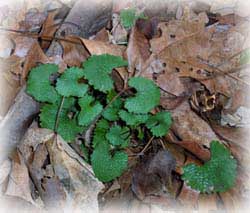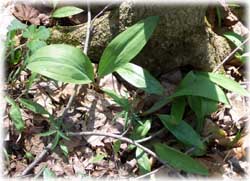Wild Foods
General Information about wild foods.(Please don't harvest plants in public parks or preserves, leave them for others to enjoy.)
Early Americans lived on wild foods, whether plants, or game which they hunted. The staple foods of the native inhabitants of our northeast Ohio landscape would seem as foreign to us as the cuisines of Afghanistan or India. Yet, the woods abounds with such fare, if only we knew how to identify and prepare it.

Garlic Mustard, an edible non-native herb brought to America by europeans.
For example, acorns were a major food source for many of the native Americans. They ate flour made from acorns, acorn porridge, and even coffee brewed from roasted acorns. This may have been supplemented with a desert of mayapples. When's the last time you ate acorn soup or devoured a fresh mayapple?
Assuming proper identification, and proper sustainable harvesting techniques, supplementing your everyday diet with some wild foods can be a healthy way to re-connect yourself with the natural world. Just remember not to harvest plants on public lands. If we all did that, soon the beautiful landscapes we all love would look like the open forests of europe, the understory depleted by repeated heavy harvesting.

Ramps or Wild Leeks
(Allium tricoccum)
If you have access to private land with populations of edible plants, be sure that you do not take all of the plants. When harvesting perennial plants be sure to leave at least part of the root, as many perennials wil re-sprout from the root fragments left behind. Additionally, it is smart to spread or plant the seeds of the plants you harvest in the same area you take the plants from. In this way you will be less likely to permanently deplete the wild foods of the area.
The key to eating wild foods is not in the preparation, it is in being confident of your identification. The guide listed to the left of the text is a great place to start. It is critical that you do not mis-identify a plant you intend to eat, for some plants may be harmful if eaten. In fact, certain parts of a plant may be edible, while other parts of the same plant will make you seriously ill. Only eat a plant if you thoroughly understand how to identify it, which parts are edible, and how to prepare it.
Links to Wild Food Recipes
Wild-harvest.com
The Really wild food guide
Herbal Recipes
Native American Food and Recipes
Wild Food Adventures
Organic Annie's Wild Food Recipes
Edible Weeds
